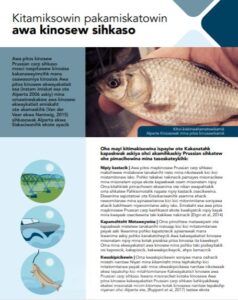Prussian Carp (Carassius gibelio)
Lorem ipsum dolor sit amet, consectetur adipiscing elit. Ut elit tellus, luctus nec ullamcorper mattis, pulvinar dapibus leo.



Images from the University of Alberta Fisheries & Aquatic Conservation Lab
Order: Cypriniformes
Family: Cyprinidae
Prussian Carp are silvery-brown-bodied fish that closely resemble Goldfish. They can live between 5 to 10 years and spawn several times per year. They can reproduce asexually through gynogenesis, which is a reproductive process that exploits the sperm of other fish species in the water column to activate egg development and gives rise to new females which are essentially clones. This reproductive interference can cause adverse effects to native fish species.
Prussian Carp are an extremely hardy species that can tolerate a wide range of environmental conditions. This species has been found in aquatic environments with low oxygen and poor water quality that are not suitable for native fish species. It is also a habitat and feeding generalist, that can outcompete native species for food and habitat. These life-history characteristics make it a prolific invader which threatens the ecological integrity of aquatic ecosystems.
Prussian Carp is currently only found in Alberta and Saskatchewan in North America. To help prevent further spread of Prussian Carp do not transport or release live fish into any waterbody and make sure to always wash your equipment after being in the water.
General Information
Prussian Carp are silvery-brown bodied fish which can grow to as much as 30 cm in length and 3 kg in mass. They are morphologically similar to two closely related species within the Carassius genus, the Goldfish (Carassius auratus) and the Crucian Carp (Carassius carassius). Prussian Carp and Crucian Carp are easier to distinguish based on the shape of the dorsal fine (Prussian Carp is concave, Crucian Carp is convex) and the peritoneum color (Prussian Carp is black, Crucian Carp is white) (Elgin et al., 2014). It is more challenging to differentiate between Prussian Carp and Goldfish, as the only distinguishing character between the two species being their colour (Prussian Carp is silvery-brown, whereas the Goldfish is golden brown-bronze), which can be difficult to judge (Elgin et al., 2014).
Native Range: It is thought to be native to central Europe and Asia, however the native range is not clearly defined due to early introductions elsewhere in Europe, confusion with the morphologically similar Goldfish (Carassius auratus), and complex reproductive methods (Froese & Pauly, 2019).
Invasive Range: Prussian Carp was first discovered in North America in 2006, specifically in the Canadian Prairie province of Alberta, however recent analyses of historical specimens have confirmed the presence of Prussian Carp in Alberta in 2000 and Saskatchewan in 2006 (Docherty et al., 2017; Elgin et al., 2014). There are currently no known records of the species elsewhere in North America. It is unclear how it was first introduced to Canadian waters, however accidental escape from aquaculture areas or from aquarium release is likely (Elgin et al., 2014). While this species is not typically grown in aquaculture or sold in the aquarium industry in Canada, it is possible that it was imported alongside two closely related species the Koi Carp (Cyprinus carpio) and the Goldfish (Carassius auratus).
Click here to view a distribution map.
- Prussian Carp is a habitat generalist and can tolerate a wide range of environmental conditions. It has been found in areas with poor water quality and low oxygen that is not suitable for native fish species. It has been shown to cause degradation and alterations to habitat quality, which poses a risk to native fish species.
- Prussian Carp uses a reproductive process which exploits the sperm of other fish species to essentially produce clones which can interfere with the reproductive rates of native fish species and cause declines in native fish populations. It can reproduce several times per year which allows it to increase in population size very rapidly.
- This species is a feeding generalist that can outcompete native species for food, particularly when populations are large.
- A recent study in Alberta found that native fish abundance was four times lower after Prussian Carp invasion (Ruppert et al., 2017). Additionally, higher abundances of Prussian Carp were significantly associated with lower abundances of many native fish species. This study also found that Prussian Carp are associated with a decrease in diversity of benthic communities (Ruppert et al., 2017).
- Prussian Carp has been established in Europe for hundreds of years and is considered one of Europe’s worst aquatic invasive species. It was found to have the highest ecological and economic impacts of all invasive fish species established in Europe, with greater impacts than Grass Carp (Ctenopharyngodon Idella) (van der Veer & Nentwig, 2015).
- Prussian Carp have been found in higher abundances in irrigation infrastructure including drainage canals and reservoirs than natural waterways. This poses a risk of reduced water quality and increase the risk of spread throughout the Canadian Prairies as irrigation canals are interconnected across the landscape.
Resources
Research
Erick L. Elgin, Haley R. Tunna and Leland J. Jackson
Cassandra Docherty, Jonathan Ruppert, Tyana Rudolfsen, Andreas Hamann and Mark S. Poesch
Jonathan L. W. Ruppert, Cassandra Docherty, Kenton Neufeld, Kyle Hamilton, Laura MacPherson and Mark S. Poesch
Jamie T. Card; Caleb T Hasler; Jonathan L.W. Ruppert; Caitlyn Donadt; Mark S. Poesch




